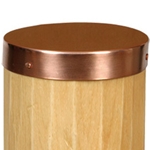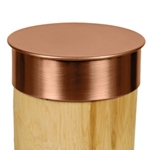Several ways to effectively protect the end grain on log and timber structures is in design considerations, borate and stain saturation, end grain sealers, and physical barriers like decorative caps and post jacks.
Design Considerations
The most important consideration for protecting wood from decay is in design. Long roof overhangs are well worth the extra cost in the protection they give to logs and timbers. Log ends should not jut past the roofline or sit in the path of a dripline. Although timbers reaching past a roofline may look neat, design should follow function, and leaving the end grain exposed to prolonged moisture exposure is a formula for decay.
One easy way to help protect end grain from prolonged moisture exposure is to profile horizontal logs with a back-slanted cut. An angle of cut that leaves end grain facing upward will collect water and channel it back into the log. A straight vertical cut would be preferable. Even better would be a profile that slants backward so that the end grain is protected under the overhang of the log itself, in addition to the roof protection.
The design of post placement is also an important consideration. Moisture doesn't only come from above as rain, but it can be absorbed from below as moisture from the ground or as sitting rainwater on the slab. Log or timber posts that sit right on the slab will suck up water like a straw and quickly lead to decay. Protecting that end grain with a sealer, a sill seal, and/or even better with a vertical lift, and the log post will last indefinitely. Vertical life can come from post screw jacks or even stone or concrete footings with a moisture barrier between.
Saturation with Borates and Stain/Finish
Regardless of how the end grain will be protected, first saturating the raw wood with a copper preservative or borate preservative (such as PeneTreat or ArmorGuard) will provide rot protection in the wood in case of moisture exposure. Additionally or alternatively for log or timber ends that might be in high risk due to moisture exposure, concentrated preservative rods like Bor8 Rods or Cobra Rods are also an option.
To block the absorption of moisture into the wood, it's beneficial to saturate the end grain with whatever stain or finish is being used on the rest of the home. This can be soaked into the end grain to the point of refusal so that being saturated with the resin and solids of the stain, it will not be able to take on water so easily in the future.
End Grain Sealers
In addition to saturation with the stain/finish being used on the rest of the log surface, some opt to give the end grain and additional layer of clear coat protection with an end grain sealer. This could be just an extra later of the top clear coat from the stain system being used, or it could be a sealer designed specifically for end grain. Two options available on the market are oil-based Log-Gevity End Grain Sealer or water-based Log End Seal.

 Decorative Caps
Decorative CapsDecorative post caps are a popular choice for vertical posts. Both functional as well as aesthetic, decorative caps, such as copper post caps, are a way to protect the upward-exposed end grain while also adding an accent to wood structures.
Sill Seals and Jacks
Protecting the bottoms of vertical log and timber posts is important so that they don't wick up water from the ground or concrete slab. A closed cell sill seal is one way to do this. Post screw jacks also help keep the bottoms of the post from wicking moisture, while they also allow vertical posts to settle with newly constructed log walls.

By protecting the end grain from water and taking other precautions to keep moisture out of the wood, log and timber structures can last centuries to come. Contact Schroeder Log Home Supply, Inc. with any questions about protecting the end grain of logs and timbers.
Questions? Give us a call at 1-800-359-6614 or contact us through our website here.
Schroeder Log Home Supply, Inc.





No comments:
Post a Comment